October 22, 2016
Relationally You, Relationally Constructed
Written by Lorena Morales Aparicio
I was surprised by Nicholas Bourriaud’s 1991 Relational Aesthetics that but few sentences were devoted to addressing the body politic. Bourriaud, in his attempt to rupture what Benjamin asserted as the aura of the classified or exclusive art work, unwittingly added to its burden. Although relational aesthetics attempts to break down the walls between strangers to generate authentic and unpremeditated connections, how does one account for the attempted sublation of each participant’s psyche? As the psyche is formed from experiences in the world, how can an aesthetic experience transform years of histories and ingrained (acculturated) psychological structures into substantive new desires and thus newly directed drives? These individual psychic structures enforce existing social structures and codes even as Bourriaud argues for a momentary dissolution of the status quo for a group selfreflexive experience. It is the return from the suspension of the quotidian experience, from then looking back and interpreting the moment for meaning, that a person confronts the disparities and lack within themselves and within the social structure (Figure 1).
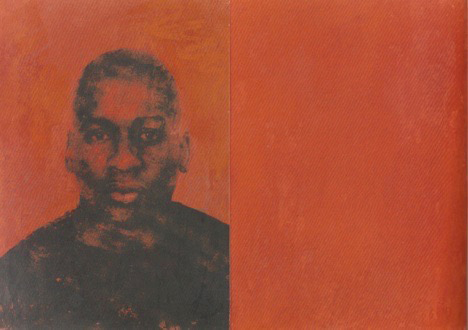
American black art is consistently interpreted as a political, economic, social and psychological response to slavery and racism. Art historical scholarship on American black art has a tendency to celebrate the lone, token black artist: the artist of rare genius by virtue of minority and marginality. Apart from the infrequent editor, curator and academic, black artists and their production have been denied universality by such codified statements masquerading as criticism. It is mainly within the domain of black cultural studies that rich, intertextual scholarship on black art has been produced.
The oeuvre of Glenn Ligon, who rose to international recognition during the identity politics of the 1990s, carefully examines the trope of being a black man in the (art) world. Further, the trope of being a black, gay man in the (art) world. Ligon’s 2011 mid-career exhibition / installation Glenn Ligon: America (Figure 2) at the Whitney Museum of American Art created a participatory dialogue between Ligon’s works and the public. Many of Ligon’s works incorporate text, which require active readership, or speaking,1 on the part of the viewer, thus creating a direct discourse between established, particular, subjective ideas of universality and marginality, black and white, gay and straight. These aforementioned binaries, some of many, remain simple in the habitual critique of art in general. Ligon creates a liminality where each side of the binary is recognized and understood in the interpretative gap of the antinomy. Here the sign (or an idea in form) is in suspension where Freud tells us the Ego must supply a bridge of meaning, or content, between the sign’s antimony in relation to the person. As Bourriaud would acknowledge, the liminal aesthetic and psychic states that Ligon’s artworks evoke don’t merely filter consciousness through a seemingly homogenized screen: they provoke multitude and difference.

Bourriaud argues for art works that require such interaction with the audience. Bourriaud considers relational aesthetics as an ideal construction of artistic form and content intent on recuperating social man’s alienation and separation post-Modernity, post-utopian “Isms” (Marxism, Fascism), by providing creative moments of a spontaneously shared experience. An example of this is Rirkrit Tiravanija’s Untitled 1992/1995 (free/still) (Figure 3) where museum or gallery visitors sit at tables together enjoying Thai food prepared by the artist, for free. While Bourriaud does argue in a relatively short passage that the resolution of or even the mediation of racial, political, and gender discourses are not intended for the pure idealized form, space, and time of a participatory work of art. This paper assesses Ligon’s aesthetic vis-a-vis that of Bourriaud, examining the inherent difficulty of casting relational aesthetics in only a Greenbergian formalism. This paper culminates in the very real (not ideal) problem of “participation” as experienced by Ligon, where the locus of “participation” occurs primarily in Ligon’s own persona, before being cast as public dialogue. Arguably, Ligon relevantly uses himself as a living example to recuperate social man from social man himself.
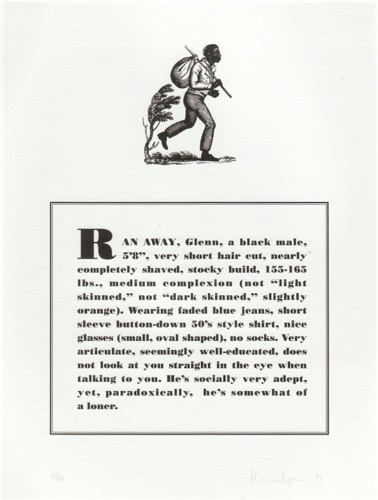
Glenn Ligon originally envisioned his artistic career as a neo-Abstract Expressionist painter. Abstract Expressionism is understood as heroic, recapitulative, gestural, American, not to mention masculine. Ligon’s Untitled, 1988 exemplifies the archetypal Abstract Expressionist style of painting. In the varied passages of fgreens, punctuated by spontaneous spurts of bright ochre, there is the trompe l’oeil of the two-dimensional, Hans- Hoffmanian (Figure 4) optical push and pull based on comparative color theory. Although Ligon’s Untitled, 1988 (Figure 5) only measures 16 x 12 inches, it captures the essence of the Abstract Expressionist moment. It is Ligon’s meditation on a uniquely American moment in the post-war international art world as much as it is Ligon’s nascent effort to create a relevant body of work within the accepted, canonical model of post-War art. I suggest it also functions as a commemoration and innocent celebration of painting in its purity: painting for its own sake.
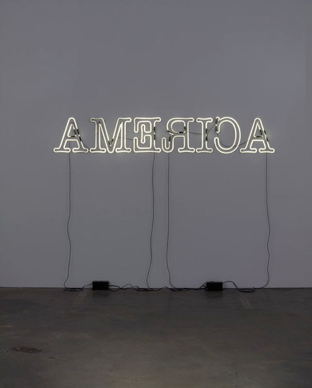
Untitled, 1988 establishes the trajectory for Ligon’s oeuvre. The artist addresses the epistemology of the purity of form (a metaphor for being in relation to Absolute, Universal ideas) while suspending his own identity, his own processes, in favor of the painter’s general formal process. However, this is illusory and inconclusive, as the artwork is never truly devoid of meaning, of content. We intuit the lack of the all too human nature that betrays goodly universal ideas such as Painting, Beauty, and Democracy. For Ligon, this nature of Hoffman’s visual push and pull posits an antimony of form without content, where form also frames an excess of content. If form without content is the ideal, its reciprocal is the excess of inhumanity.
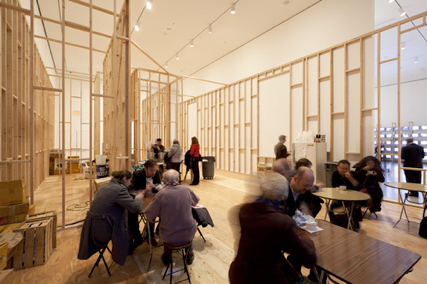
Scott Rothkopf begins the catalogue for The Whitney Museum of American Art’s 2011 mid-career Ligon retrospective America citing Ligon’s dissatisfaction with the Abstract Expressionist paintings of William de Kooning and Jackson Pollock (Figure 6). The Abstract Expressionist style proves hardly utopian. It is not a perfect existential harmony between the universal (or general), the particular (the politicized social), and the singular (or individual). As a purely formal experience, Abstract Expressionism failed to recuperate Western culture during its revolutionary moments of potential in the vulnerable, cathartic moments after World War II. Ligon’s body of work after his experiment with Untitled, 1988 seeks to preserve a singular identity against the historical, insipidly totalitizing pathology of the particular society attempting to reconcile itself with the universal.

Clement Greenberg, one of America’s seminal cultural philosophers and formal art theorists, claimed the arrival of pure painting, in other words painting for itself, in the Abstract Expressionist moment. For Greenberg, painting and sculpture finally lost the subjectivity which, for a formalist, obfuscated the true purpose of the medium: absolutes based upon universally positivist, undeniably whole and incorruptible things (forms) such as color, value, saturation, and gesture. It became a utopian dialogue where the facticity of paint was removed from economy, politics and society. For Greenberg, Abstract Expressionist painting unified the audience at the most basic, essential level: a universal recognition of basic forms painted in universally empathetic expressive gestures and color.
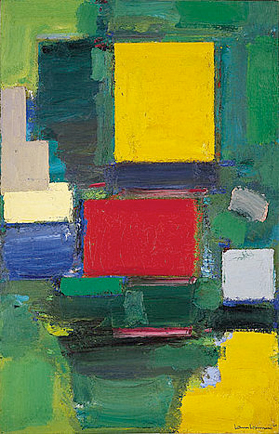
Greenberg’s structure is the semiotics of a utopian language of form. Utopia was an ideal considered attainable given the relative economic emancipation of modern man through labor from the late nineteenth century forward. If the work of art, according to Greenberg, is a thing “separate and irreducible” in itself, can this metaphysic, by virtue of its production into a work of art, exist beyond the ideal? In laboring to convert an ad populum society back to essential value (away from the watered down cultural simulacra of kitsch that recycles Old Master forms) does this prove that utopia has finally come into existence? Marxism, Fascism, and Communism are all failed experiments illustrated as by the failed utopian, integrative buildings of Le Corbusier.
Bourriaud claims that such a utopia can temporarily exist, exemplified by the socially integrating, temporary works by artists such as Rikrit Tirivanija, Tino Seghal and Pawel Althamer. By creating a moment suspended from everyday reality, rupture in the established fabric of society occurs. This forces, however gently or abruptly, a reassessment of individual process, of choice. In The Parallax View Slavoj Žižek elaborates on the individual’s evolving points of view based on antimonies created, not by simple binaries, but from the relationship required to bridge the gaps in ruptures of meaning. Between the antimony and the individual who is positioned somewhere outside of the totality of the antimony. The individual requires noumenal process and interpolation to close the gap between him/herself and an idea that exists. The process as value is dynamic. Within the antimony of the All, there is the non-All. Žižek calls this “minimal difference,” defined as the coincidence and non-coincidence of essence. It is defined as the existence of the essence as a whole defined by slight differentials between similar yet nuanced essences. For instance, a Moroccan expatriate who lives in America and regularly reads the newspapers from France to gain a true, or seemingly unbiased, perspective on American political, economic and social phenomenon seeks the minimal difference of the essence of Equality. Essence then becomes a seemingly thinking subject with bias through the process of reconciliation between it and the individual. The individual projects onto the substance thus alchemically transforming the substance into a principled, acting subject. The substance as subject begins to speak by its integration in a projected dialogue created by the individual.
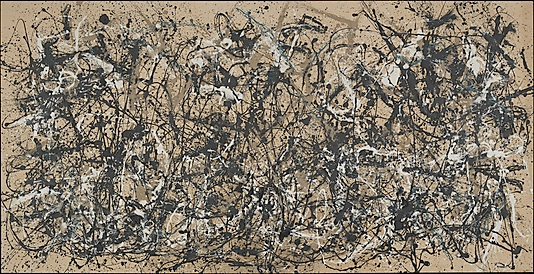
Ligon begins his intervention, or rupture, with doors, linen canvases and paper glimmering with text made from shimmering, black oil stick (Figure 7). Further, he uses stencils to guide the oil stick. Regarding a temporary utopia experienced by an absolute formalism, the stencil Ligon uses repeatedly is an aesthetic form in itself. It is an empty form, it is an empty frame, it is an empty sign until meaningful words are spelled out. The stencil creates a specific yet same, or universal, typology: a type, a form, a text. The use of the same stencil across Ligon’s oeuvre generalizes the text, very much as Times New Roman font is standard global business practice for clear and hopefully well articulated communication. The stencil thus becomes a pure form in itself, at once distinct from Ligon’s signification as an artist, as a man even as it is his own artistic choice, his gesture. At first, it creates a general, or universal, signification. The stencil’s pure form, this intellectual bracketing or potential framing of content, makes the content in Ligon’s artworks all the more remarkable in that the quotations of text appropriated by Ligon (quotations taken from writers such as James Baldwin, Gertrude Stein, Richard Pryor and gay pornography) appear impersonal.
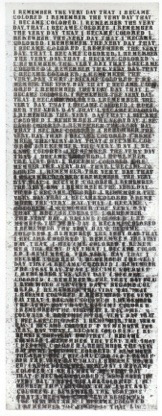
In this initial neutrality the text invites the participant to fill a seemingly empty sign, a bracket, a frame of reference, with his or her own subjective response to the quotations. In other words, with particular social and political content. It is an exchange. Rothkopf writes, “The strain of looking and reading extends to our sense of being visible to others and to ourselves. Ligon’s door paintings make us wonder afresh what it means to be somebody--to be anybody, really--in relation to somebody or to anyone else.”2 (Figure 8) Ligon’s artistic choice of the same stencil frames the myriad narrative structures of the audience’s psyche in an innocuous way, allowing for an moment of individual suspension or sublimation, followed by meditation on and reaction to Ligon’s text. Given the provocative nature of the appropriated texts, Ligon’s rupture is Brechtian in function. It shocks the viewer out of complacency and into a cathartic reflection. Yet how does Ligon perceive his audience? Untitled (I Remember the Very Day That I Became Colored), 1990 is a tacit indictment of Anglo-Saxon hegemony and directly signifying the black / white antimony. The antinomy of the non-All and the All.
The first gallery of The Whitney’s Ligon retrospective exhibited a black neon sign with “America” spelled backwards and in reverse. Again this is another seemingly simple antinomy of ideal America and the America as experienced by the non-All. The museum’s front window overlooks the luxe, shop-filled Madison Avenue contained another prominent, black neon sign that illuminated the text “negro sunshine,” taken from Gertrude Stein. In a discussion with the art historian Huey Copeland at the Whitney Museum, Ligon asserted , “there are no negroes for sale here.” Ligon’s imperative calls attention to the particular of being black, living and working within a prominent, capitalistic democracy. The non-Majority, or plurality, in minimal difference with the Majority. The human texture is removed and the subject becomes a thing that is functional with a codified form.
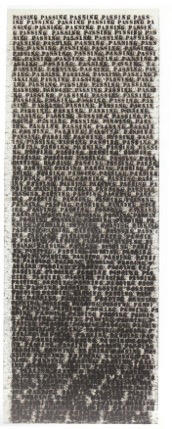
The great Marxist, cultural critic Walter Benjamin asserted that the rarified artwork is transmuted into a commodity. Its immediate accessibility through mass produced replicas contrast with the actual work of art located at the remove of a museum, a gallery, a private collection--in other words, located at location requiring the expenditure of time and income to experience. The artwork in reproduction thus loses its austere aura, the aura resulting from its unique distillation of ideas, of history, of humanity equally for the initiated (the cult) and the curious. Reproduced as a postcard, as a digital image, as part of an advertisement, the work of art becomes a fetishized marker of an ersatz and thus superficial community. People project their dreams onto objects, visually associating and constructing identity with things which include images. Things become viable, important nuances to their life’s narratives. This is Ligon’s main audience: the audience visiting the Whitney Museum, captivated not by the art, but by an association with the museum’s socio-economic and high cultural positioning. This is an association that will impart legitimacy, status, upon the admission paying public--upon the consumer public. The manner of reducing life to the simple signification of people as marketable and thus containable commodities (black / white, educated / noneducated) informs the relationships between social groups in terms of work or public existence that transposes into the leisure or private experiences. A social division can be signified by the lack of or possession of color, of the All or of the non-All. While Clement Greenberg affirms “the golden umbilical” cord (those members of the socioeconomic elite that find value in experimentation with established paradigms to improve values and thus systems) as a pivotal support of the avant-garde, there is not a benefit to the resultant mass produced copies of the original artwork that filter down to the retail level for everyone and for no one simultaneously. Pure formalism, or utopia, is a proven social fallacy.
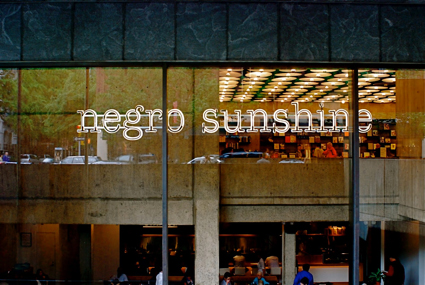
Claire Bishop, the leading art historian and critic for Participatory Art and relational aesthetics, interrogates Walter Benjamin’s position in her book Artificial Hells. Bishop attempts to find a place for participatory art, evaluated in art historical critical terms, as opposed to being reduced to basic Marxist theories of exchange. Bishop rightly criticizes the political and business trend of the last decade in the United Kingdom and on the Continent which encourage creativity to produce employees with multi-faceted, transferrable skill sets. These employees will arguably weather the risks of employment successfully rather than lapsing into welfare programs and crime.
Bishop cogently asserts that these works of relational aesthetics demand consideration from an art historical perspective and not from quantifiable social and economic statistics. The form of a participatory, or relational, work of art should strive, in Bishop’s words, to “occupy an ambiguous territory”3 where the line between art and life is blurred, or, again, suspended. Assessing Lacan’s ethics on art, Bishop continues that “suspending and disarming desire (as opposed to extinguishing and tempering it) ... provides access to subjective ‘good.’”4 If the subjective “good” is in fact identifiable by each individual, social recuperation can occur. The conceit is that the Good is simultaneously and equally understood , or framed, in the same terms, or form, by everyone present.
Although the type of participatory, or relational, art that Bishop engages with are performances and communal experiences guided by an artist’s or collective’s framing idea, we can still assess Ligon in these terms. How so? Bishop reminds us that most people cannot attend these ephemeral and site-specific participatory artworks. Thus these participatory artworks are experienced secondarily, through photographs, videos, documents, films and props. Ligon’s works are indeed like paintings where an established hierarchy still exits (one remembers the start of Modernism with the early Renaissance painters), yet, the reading of the text impels collaboration from the viewer resulting in discursiveness with Ligon’s works. The viewer instantly becomes a co-creator, a co-author. As Ligon’s works are strongly autobiographical, the viewer participates in the very real history of the artist himself. While Žižek does not believe in identity politics, rather that we should subscribe to ideas that will cut a swath through humanity, his explication of difference as non-coincidence with the One is useful.
What happens when this difference is imposed by a group unified by a structure of ideas upon another? Curator Thelma Golden argues that “Black masculinity suffers not just from overrepresentation, but oversimplification, demonization and (at times) utter comprehension.”5 In other words, simple binaries, or, objectification. Ligon’s crux is to maintain a “preserve [of] cultural integrity”6 given “the empirical evidence.”7 Untitled, 1988 demonstrates Ligon’s exploration of his dream as a cultural producer within the idiom of the canonical avant-garde. Abstract Expressionism, we have discussed, is idealized as painting as pure process removed from content. Yet Ligon realized that its idiom did not permit an exegesis of what Franz Fanton explains in Black Skins, White Masks, of the imposed neurosis of racial alienation. Accessing racism from his discipline of psychology, Fanton writes: “The neurotic structure of an individual is precisely the elaboration, the formation, and the birth of conflicting knots in the ego, stemming on the one hand from the environment and on the other from the entirely personal way this individual reacts to these influences.”8
Relational aesthetics is problematized by Ligon. While being relational is coded as reform, being relational becomes compulsory when the constructed Ego ceases to sublate itself within the activity. Signs, thus meaning, are produced that impel closure between their antimony and the conflicted individual’s noumenal relationships with it. By titling the Whitney retrospective “Glen Ligon: America,” the artist confirms the interpolation of national identity at the individual, singular level. Ligon confirms the interpolation of the universal through the singular and how it is not congruent. He arguably creates noumenal reliquaries that speak and breath his life’s praxis, confronting and impelling an accountability of continuing racial and social structures. Ligon’s artworks embody a relational aesthetic as his experiential essences are suspended and speak from the interpolating artwork. Ligon and Bourriaud seek to foment authentic social experiences based on a real yet temporary suspension of and Brechtian challenge to the quotidian. Ligon’s challenge to pathological hegemonies is a will to truth, experienced from Fanon’s double consciousness in the parallax of interpreting Reality and Forms through a subjective objectivity. Ligon involves us in the full tapestry of life: gracious form that behooves meaning, a parallel to the social forms and formalisms observed and reified by man every moment of his existence.
Lorena Morales Aparicio is a Ph.D. Student in Philosophy, Aesthetics & Art Theory at The Institute for Doctoral Studies in the Visual Arts (IDSVA), Portland, ME.
1 Okwui Enwezor, “Text, Subtext, Intertext: Painting, Language, and Signifying in the Work of Glenn Ligon,” in Glenn Ligon: America. Editor Scott Rothkopf (New Haven: Yale University Press, 2011), 55.
2 Scott Rothkopf. Glen Ligon: America. (New Haven: Yale University Press, 2011), 29.
3 Claire Bishop, Artificial Hells. (Brooklyn: Verso, 2012), 40.
4 Bishop, 39.
5 Thelma Golden, “My Brother,” in Black Representations of Masculinity in Contemporary American Art (New York: Harry N. Abrahms, 1994), 25.
6 Stokely Carmichael and Charles V. Hamilton. Black Power: The Politics of Liberation in America. (New York, Random House, 1967), 56.
7 Carmichael and Hamilton, 56.
8 Frantz Fanon. Black Skin, White Masks. Translated by Richard Philcox (New York: Grove Press, 1967), 62.
Bibliography
Bishop, Claire. Artificial Hells. Brooklyn: Verso, 2012.
Bourriaud, Nicholas. Relational Aesthetics. Les Presses Du Reel, 1998.
Critical Art Ensemble, “Observations on Collective Cultural Action,” Art Journal, Vol. 57, No. 2 (Summer 1998), 72-85.
DeVere Brody, Jennifer and Dwight A. McBride, “Plum Nelly,” Callaloo Vol 23, No. 1 (Winter 2000), 286-288.
English, Darby. How to See a Work of Art in Total Darkness. Cambridge: The MIT Press, 2010.
Fanon, Frantz. Black Skin, White Masks. Translated by Richard Philcox. New York: Grove Press, 1967.
Gablik, Suzi, “Connective Aesthetics,” American Art, Vol. 6., No. 2 (Spring 1992), 2-7.
Ghaziani, Amin, “Post-Gay Collective Identity Construction,” Social Problems, vol. 58, No. 1 (February 2011), 99.
Greenberg, Clement. Art and Culture: Critical Essays. Boston: Beacon Press, 1961.
Golden, Thelma. BLACK Representations of Masculinity in Contemporary American Art. New York: Harry N. Abrams, 1994.
Iheduru, Obioma. “Social Values, Democracy, and the Problem of African American Identity.” Journal of Black Studies Vol. 37, No 2 (November 2006): 209-230.
Ligon, Glenn, panel discussion with Huey Copeland and Scott Rothkopf, The Whitney Museum of Art, New York, NY, April 21, 2011.
Ligon, Glenn. Coloring: New Work by Glenn Ligon. Minneapolis: Walker Art Center, 2001.
Ligon, Glenn. Yourself in the World: Selected Writings and Interviews. Scott Rothkopf, ed. New Haven: Yale University Press, 2011.
Lubiano, Wahneema, “Mapping the Interstices between Afro-American Cultural Discourse and Cultural Studies: A Prolegomenon,” Callaloo Vol. 19, No. 1 Winter 1996, 68 -77.
McBride, Dwight A., “Toward the New Black Studies: Or Beyond the Old Race Man,” Journal of Black Studies: Sustaining Black Studies, Vol. 37, No. 3 (January 2007), 428-444.
Perchuck, Andrew and Helaine Posner, eds. The Masculine Masquerade: Masculinity and Representation (Cambridge: The MIT Press, 1995).
Piper, Adrian, “Xenophobia and the Indexical Present II: Lecture,” in Out of Order, Out of Sight, Volume I: Selected Writings in Meta-Art (Cambridge, Mass: MIT press, 1996), 267-268.
Rothkopf, Scott, ed. Glenn Ligon: America. New Haven: Yale University Press, 2011.
Tannenbaum, Judith. Glenn Ligon: un/becoming. Philadelphia: Institute of Contemporary Art, University of Pennsylvania, 1997.
Van Horne, Winston, “The Concept of Black Power, It’s Continued Relevance,” Journal of Black Studies, Vol. 37, No. 3 (Jan 2007): 365-389.
Walker, Rebecca and Henry Louis Gates, Jr. Black Cool: One Thousand Streams of Blackness. Berkeley: Soft Skull Press, 2012.
Žižek, Slavoj. The Parallax View (Short Circuits). Cambridge: The MIT Press, 2009.









